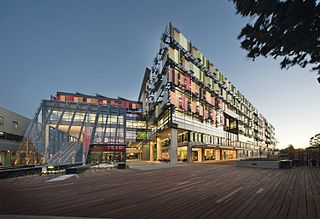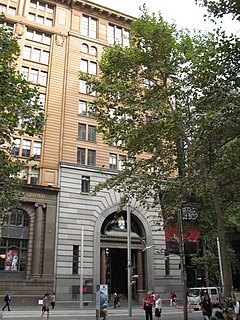
Bendigo and Adelaide Bank is an Australian financial institution, operating primarily in retail banking. The company was formed by the merger of Bendigo Bank and Adelaide Bank in November 2007.

The Bank of New South Wales (BNSW), also known commonly as The Wales, was the first bank in Australia, being established in Sydney in 1817 and situated on Broadway. During the 19th century, the Bank opened branches throughout Australia and New Zealand, expanding into Oceania in the 20th century. It merged with many other financial institutions, finally merging with the Commercial Bank of Australia in 1982 to form the Westpac Banking Corporation.
Banking in Australia is dominated by four major banks: Commonwealth Bank of Australia, Westpac Banking Corporation, Australia and New Zealand Banking Group, and National Australia Bank. There are several smaller banks with a presence throughout the country, and a large number of other financial institutions, such as credit unions, building societies and mutual banks, which provide limited banking-type services and are described as authorised deposit-taking Institutions. Many large foreign banks have a presence, but few have a retail banking presence. The central bank is the Reserve Bank of Australia (RBA). Since 2008 the Australian government has guaranteed deposits up to $250,000 per customer per institution against banking failure.
A mutual savings bank is a financial institution chartered by a central or regional government, without capital stock, that is owned by its members who subscribe to a common fund. From this fund claims, loans, etc., are paid. Profits after deductions are shared among the members. The institution is intended to provide a safe place for individual members to save and to invest those savings in mortgages, loans, stocks, bonds and other securities and to share in any profits or losses that result. The members own the business.
HSBC Bank Australia Limited was granted a banking licence in 1986 by APRA having been established as HSBC Finance Company Limited in 1965. It is part of the worldwide HSBC Group. HSBC Bank Australia is a foreign bank in Australia, offering a wide range of banking products and services to the retail, commercial, corporate and institutional sectors.
The Adelaide Bank was a publicly listed bank with its head office in Adelaide, South Australia. It was established on 1 January 1994 from the Co-operative Building Society of South Australia Limited, which was Australia's largest building society as a result of a merger with the Hindmarsh Building Society. On 9 August 2007 it merged with the Bendigo Bank,, and Adelaide Bank shares are no-longer quoted on the ASX. Since 2008 the new entity has been known as the Bendigo and Adelaide Bank.
Westpac Banking Corporation, commonly known as Westpac, is an Australian bank and financial services provider headquartered at Westpac Place in Sydney. It was established in 1817 as the Bank of New South Wales and on May 4, 1982 merged with the Commercial Bank of Australia, becoming the Westpac Banking Corporation in October the same year. It is one of Australia's "big four" banks and is Australia's first and oldest banking institution. Its name is a portmanteau of "Western" and "Pacific".

The Adelaide Steamship Company was formed by a group of South Australian businessmen in 1875. Their aim was to control the transport of goods between Adelaide and Melbourne and profit from the need for an efficient and comfortable passenger service. For its first 100 years, the company's main activities were conventional shipping operations on the Australian coast, primary products, consumer cargoes and extensive passenger services.

Bank Australia is an Australian customer owned bank. Their stated purpose is to create mutual prosperity in the form of positive economic, social, environmental and cultural impact.
Beyond Bank is an Australian customer-owned bank operating in South Australia, the Australian Capital Territory, Western Australia and New South Wales. It provides financial services to its members including savings and business accounts, term deposits, loans, insurance and financial planning, and has total assets under management of more than $5 billion. It is a certified B Corp.
Rob Chapman is a South Australian-born businessman, CEO of St George Bank and Chairman of the Adelaide Football Club and Adelaide Airport. He is considered to be one of South Australia's most influential people.

341 George Street, Sydney is a heritage-listed bank building located at 341 George Street, in the Sydney central business district, in the City of Sydney local government area of New South Wales, Australia. It was built from 1927 to 1932 and housed the headquarters of the Bank of New South Wales, and later Westpac. It is also known as Westpac Bank building and Bank of NSW building. Westpac sold the building in 2002, but continues to lease the lower floors for use as banking chambers. The upper floors are leased by other tenants.

343 George Street, Sydney is a heritage-listed former bank building and now nine-storey retail and commercial premises. It is located at 343 George Street in the Sydney central business district, in the City of Sydney local government area of New South Wales, Australia. It was built from 1921 to 1925, and until 2008 housed banking premises of the Commercial Banking Company of Sydney (CBC) and later National Australia Bank. The building is also known as CBC Bank, NAB Bank and Barrack House. The property is now owned by the New South Wales Government-owned superannuation fund. The ground floor is leased as retail premises, while the upper storeys are used as commercial office space.










